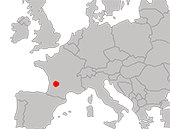- Posts: 2
- Thank you received: 0
Soyez constructifs et... courtois ! Par avance merci pour les apinautes qui dialoguent avec vous ou qui simplement vous lisent 
Production de la miel
- AudreyB
- Topic Author
- Offline
- Ponte fraiche
-

Less
More
10 May 2002 00:00 #20744
by AudreyB
Production de la miel was created by AudreyB
Bonjour à tous,
Quelqu'un peut me dire qui sont les premiers dans la histoire qui on fait production de la miel?
Quelqu'un peut me dire qui sont les premiers dans la histoire qui on fait production de la miel?
Please Log in or Create an account to join the conversation.
- Bernie26
- Offline
- Ponte fraiche
-

Less
More
- Posts: 32
- Thank you received: 0
16 May 2002 00:00 #20745
by Bernie26
Replied by Bernie26 on topic Production de la miel
Rock painting depicting honey gathering. Discovered in the Cuevas de la Arana near Bicorp in Valencia, Spain, from E. Hernendez-Pacheco, Museo nacional de ciences naturales, Madrid.
Please Log in or Create an account to join the conversation.
- AudreyB
- Topic Author
- Offline
- Ponte fraiche
-

Less
More
- Posts: 2
- Thank you received: 0
16 May 2002 00:00 #20746
by AudreyB
Replied by AudreyB on topic Production de la miel
Tnaks for the reponses...
Please Log in or Create an account to join the conversation.
- Bernie26
- Offline
- Ponte fraiche
-

Less
More
- Posts: 32
- Thank you received: 0
24 May 2002 00:00 #20747
by Bernie26
Replied by Bernie26 on topic Production de la miel
www.angus.co.uk/bibba/bibborig.html#The%20origins%20of%20honeybees
The origins of honeybees
It is thought that bees originally evolved from hunting wasps which acquired a taste for nectar and decided to become vegetarians. Fossil evidence is sparse but bees probably appeared on the planet about the same time as flowering plants in the Cretaceous period, 146 to 74 million years ago. The oldest known fossil bee, a stingless bee named Trigona prisca, was found in the Upper Cretaceous of New Jersey, U.S.A., and dates from 96 to 74 million years ago. It is indistinguishable from modern Trigona. The precursor of the honeybees may have been living about this time, but fossils of the true Apis type were first discovered in the Lower Miocene (22 to 25 million years ago) of Western Germany. A bee resembling Apis dorsata but much smaller (about the size of a present day mellifera) was present in the Upper Miocene (about 12 million years ago). It is thought that Apis florea and Apis dorsata may have existed as separate species as early as the Oligocene period. It has not been possible to estimate when bees of' the Mellifera/Cerana type first appeared on Earth. Mellifera and Cerana must have acquired separate identities during the latter part of the Tertiary era. The two species were apparently physically separated at the time of the last glaciation, and there was no subsequent contact between them until that brought about by human intervention in recent times. In the post glacial period Mellifera and Cerana (and to a less extent Dorsata and Florea) have shown similar evolution into geographical subspecies, or races.
The origins of honeybees
It is thought that bees originally evolved from hunting wasps which acquired a taste for nectar and decided to become vegetarians. Fossil evidence is sparse but bees probably appeared on the planet about the same time as flowering plants in the Cretaceous period, 146 to 74 million years ago. The oldest known fossil bee, a stingless bee named Trigona prisca, was found in the Upper Cretaceous of New Jersey, U.S.A., and dates from 96 to 74 million years ago. It is indistinguishable from modern Trigona. The precursor of the honeybees may have been living about this time, but fossils of the true Apis type were first discovered in the Lower Miocene (22 to 25 million years ago) of Western Germany. A bee resembling Apis dorsata but much smaller (about the size of a present day mellifera) was present in the Upper Miocene (about 12 million years ago). It is thought that Apis florea and Apis dorsata may have existed as separate species as early as the Oligocene period. It has not been possible to estimate when bees of' the Mellifera/Cerana type first appeared on Earth. Mellifera and Cerana must have acquired separate identities during the latter part of the Tertiary era. The two species were apparently physically separated at the time of the last glaciation, and there was no subsequent contact between them until that brought about by human intervention in recent times. In the post glacial period Mellifera and Cerana (and to a less extent Dorsata and Florea) have shown similar evolution into geographical subspecies, or races.
Please Log in or Create an account to join the conversation.
Time to create page: 0.101 seconds
































